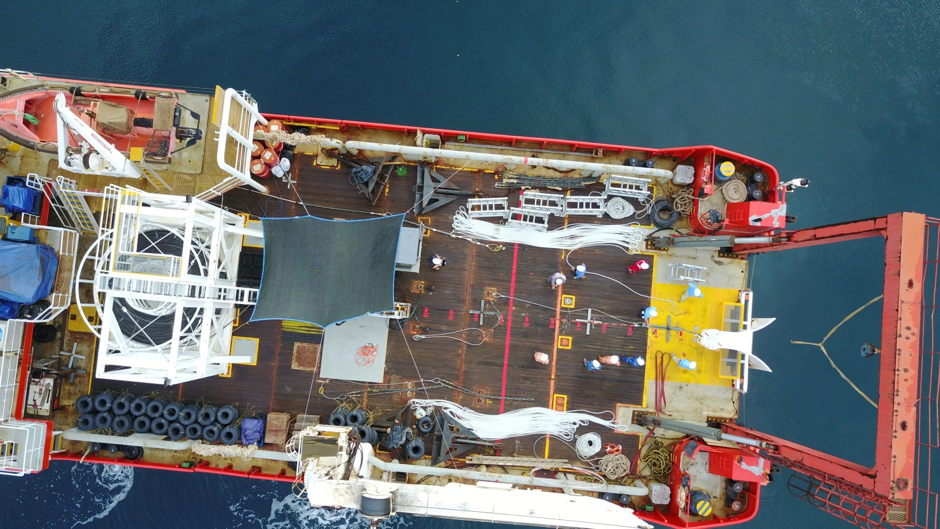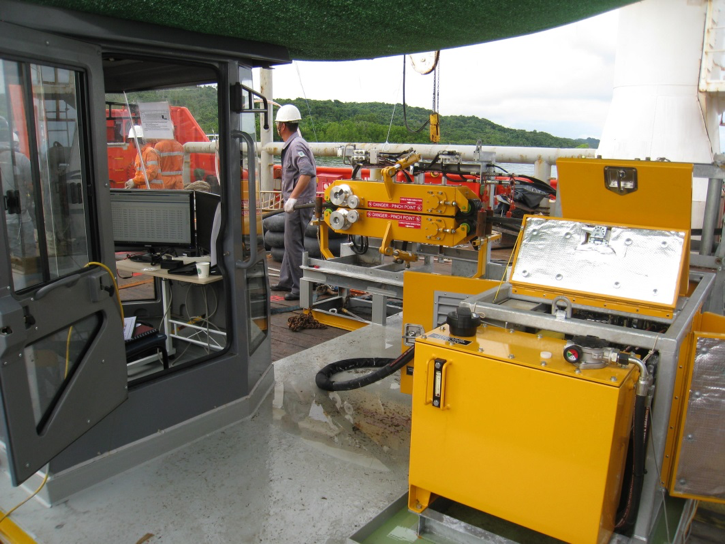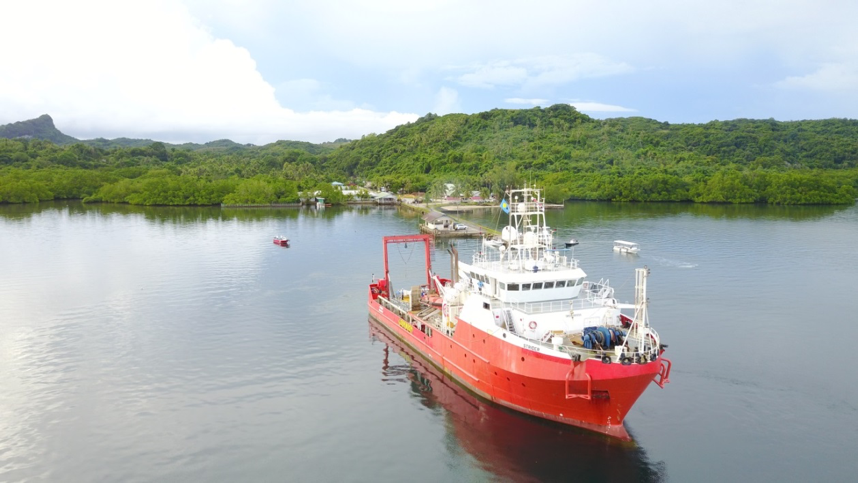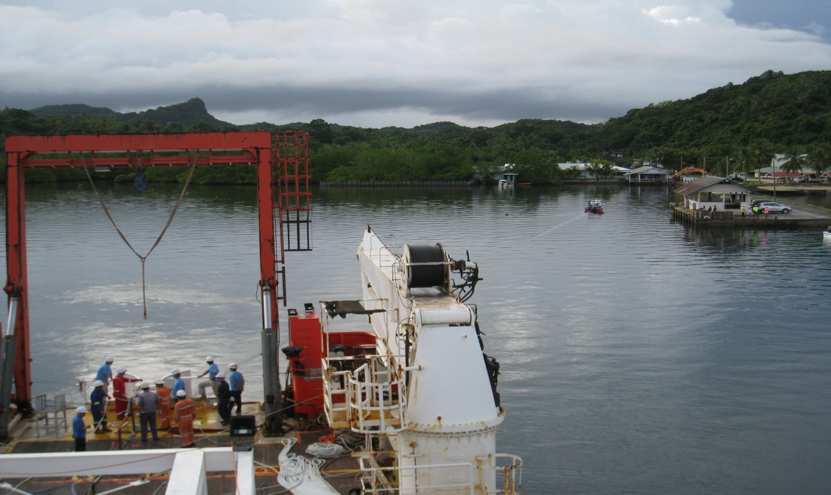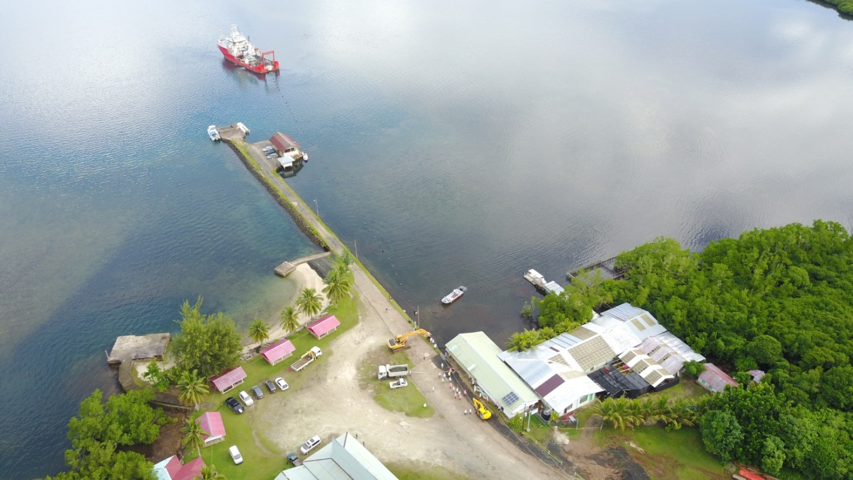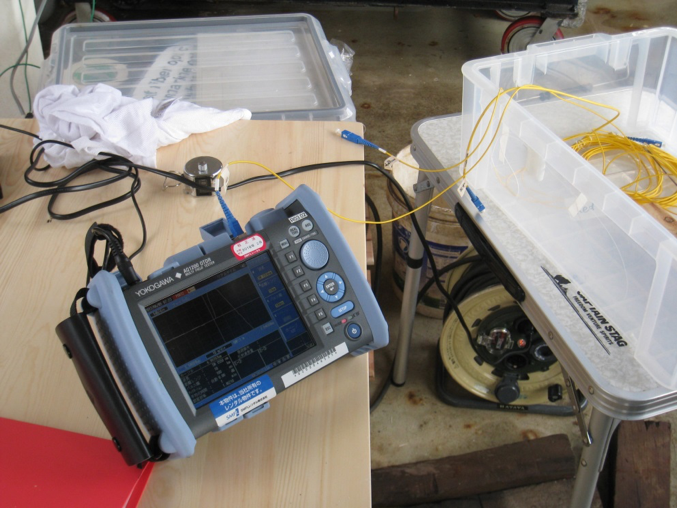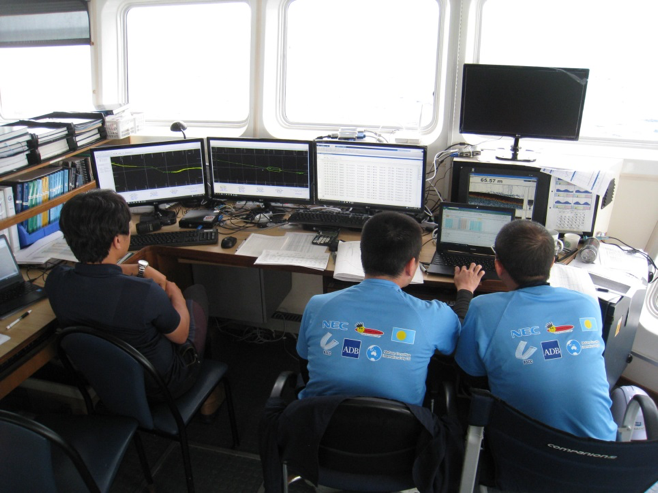PALAU Spur PLSE (Pre-Lay Shore End) Installation
BSCC representative’s Report - June 2017
INTRODUCTION
Martin Blakely representing the BSCC PMU joined the installation vessel RV Strider in Koror, Palau on 3rd June 2017 in preparation for the installation of the 6.998km length OCC manufactured type SC500-DA shore end between the landing point at Ngeremlengui out through the Western Passage (Toachel Mlengui) to the Initial Splice joint box location. The KDDI cable ship ‘Pacific Link’ is due to complete the section between initial and final splice in September 2017.
The RV Strider (formerly Mermaid Marine Australia ‘Mermaid Investigator’) is a private family owned Korean vessel operated by Wakashio Marine Pty Ltd of Singapore, built in Singapore in 2006 as a multi-role offshore supply vessel.
The vessel was mobilised with installation equipment in Busan, South Korea prior to transiting to the OCC cable factory facility at Kitakyushu, Japan for loading and testing. Loading and testing witnessed by H.Nishikawa representing BSCC PMU was completed on 25th May 2017. The vessel departed Kitakyushu for Koror on the 26th May 2017.
3rd JUNE 2017 – RV STRIDER ARRIVES IN KOROR
RV Strider arrived alongside the quayside at Koror on the morning of 3rd June and soon completed immigration formalities. Once cleared, transfer of materials to shore-side commenced including 300m of articulated pipe, bulkhead flange and BMH anchor plate. A cable roller quadrant to be setup at the landing point did not have the required temporary import documentation and would be transferred ‘floated’ ashore on site the next day and returned after the cable had been secured following installation.
A meeting was held later in the day aboard and a tour of the vessel organised for BSCC officials. Introductions were followed by discussions on the landing installation plan cable lay operation. Power safety officers (for IR testing to/from vessel/shore) were established as the two NEC testers and the number of small craft confirmed as six to be in the area (2x work boat, 2x guard boat, 1x diver boat and 1x PNCC boat). It was well known the West Passage was closed for the operation and local vessels were informed to keep well clear.
Communications on the vessel and to the Beach Master were to be by UHF radio with mobile phone as back-up.
A further safety meeting followed provided by the owner for the Korean and Indonesian crew.
4th JUNE – TRIAL SETUP AT LOCATION and CABLE LAY SIMULATION
The vessel departed Koror at daylight on the 4th June arriving on site by 07:00hrs. Trials for the DP (Dynamic Positioning) were carried out prior to the captain positioning the vessel at the intended setup location in 6m water depth off the Landing Point. The Palau pilot was helpful in pointing out all the hazards of the reef close by.
With the vessel setup on DP at the ‘start’ location (approx. KP0.330), the quadrant was over-boarded and floated to the shore towed by a workboat.
On the vessel, the intention for the day was to familiarise the crew with the equipment, location and to simulate lay operations along the entire route.
RV Strider deck layout
In addition to the Indonesian marine crew (12), there was a large contingent of personnel present representing the Korean installation company (10) as well as a team representing NEC (9) each having a specific task e.g. supervisors, operators, riggers, surveyors, testers etc.
Events during Trial Run
Vessel DP
Noticeable at first was confusion as to the capabilities of the vessel’s DP system. The system manufactured by Alstom, Norway was configured somewhat differently to some other systems and standard features i.e. moving the CoG or CoR (centre of gravity or centre of rotation) to the stern chute offset position created an unexpected response when set to ‘follow track’ mode.
The Captain explained the system capabilities to the NEC supervisor. The intention had been to set a constant vessel speed of 800m per hour and pay out cable to include slack allocation as required, however, at Alter Course points the DP computer became confused and wanted to revert back to the start of section. After two such occurrences when the vessel DP decided to return to the start of section, (the Captain was able to override the system in manual mode to maintain control) there followed much discussion on how to go about a work-around and several suggestions were trialled before a system was agreed upon. The vessel was to follow track, slowing down at Alter Courses whilst manually altering vessel heading and inputting the next section to steer and increasing speed back to 800m per hour on the straight section. The surveyors and coordinator were then able to control the cable pay-out speed by verbal commands to the LCE (linear cable engine) operator. A visit from the vessel owner transferred by small boat from the shore at roughly the same time helped calm any tension there might have been.
Whilst the events on the bridge were being discussed, work on the deck for rigging and landing operations had been progressing. The cable end had been prepared and OTDR and IR tests were conducted and confirmed as satisfactory.
At 14:00hrs, the vessel was in a position to commence its simulation of the cable lay along the route. Due to earlier lost time caused by the DP confusion, only two sections were ‘trialled’ between KP0.030 to KP1.750 and between KP4.500 and KP5.000. The vessel remained on track and was easily able to maintain power and speed throughout the trial which proved to be successful.
Linear Cable Engine (LCE) failure
During the trial run, commands were sent to the LCE operator to synchronise cable payout speed, adjusted to allow for vessel speed and slack control including infill slack.
The LCE or ‘Cable Pusher’ in use was a portable unit with separate hydraulic pump powered by a small Kubota diesel engine. (Redmond Gary Australia Pty - Cable Pusher 20kN Side Mount).
http://www.rg.com.au/cable-pusher-product.php?id=41
During the trial run and simulation, there were several ‘stops’ due to the cable pusher failing or automatically shutting down. To begin with, the reason for the stops was thought to be due to overheating of the hydraulic oil, possibly incorrect coolant in use, then possibly from interference caused by the radio frequencies in use upsetting the remote control (wireless – not hard wired for backup) and finally to the diesel engine overheating.
By the end of the day, no definite reason for the stops had been established and remained a cause for concern. The vessel remained nearby the landing point at anchor overnight.
Redmond Gary Power pack with ‘Cable Pusher’ in the background
5th JUNE – PLSE INSTALLATION
The anchor was lifted at 05:55hrs and the vessel made its way to the setup or mooring location at KP0.330.
Onshore, preparations had commenced with divers installing a rope guide along the cable route and marker buoys placed at certain positions. The quadrant was installed at the landing point held in position by the 20t excavator and the 8t excavator ready to haul the cable ashore. A tension meter was used setup nearby the quadrant.
RV Strider setup off Ngeremlengui in preparation for landing
At 06:55 the messenger rope was handed over from RV Strider to a traction boat and pulled towards the shore where it was connected to the lead rope held by the work boat.
Messenger rope being pulled ashore by work boat from RV Strider at KP0.330
View from RV Strider bridge as messenger rope pulled ashore
Aerial view showing cable being pulled ashore
By 07:12 the ‘First Buoy’ had been prepared on the vessel and with the shore-side team ready, the pull-in commenced. Buoys were continually attached at approximately 5m intervals by short strops to the DA cable as the messenger rope was pulled ashore.
Buoys being attached to the cable during pull-in
By 08:08, the cable end reached the landing point where further rigging took place using a preformed stopper connecting to the messenger wire. Divers standing at the duct entry cut buoys free as the cable was pulled ashore onto the road surface. On the vessel a marker had been placed at the 120m cable length position indicating the duct entry location and by 08:28 the marker had reached the bulkhead and the pull-in from the vessel was complete.
On the vessel, the deck was reconfigured in preparation for the lay away whilst on the shore; the cable was inserted into the duct and secured by anchor plate to the BMH. All the time, the workboats were returning the used buoys equipment i.e. rope and quadrant from the shore to the RV Strider.
Once the Beach Master was satisfied the cable was secure on the shore, divers aligned the floating cable along the intended route with slack provided from the vessel. Buoys were then progressively cut from the shore end as divers ensured the cable touched down on the seabed in the correct position with no suspensions.
By 09:00, all buoys had been cut free and with the divers clear, the vessel repositioned onto track to commence the lay away.
Lay operations proceeded as was trialled the previous day and by 10:04 the vessel was at the PNCC domestic cable crossing position when a notification was sent from the vessel. Shoreside, Richard Misech of BSCC was in continual communication with PNCC advising them of progress and when the vessel was sufficiently clear for the PNCC divers to inspect the crossing location. Once the vessel had passed by 100m a message was sent to PNCC giving permission to dive.
Note: PNCC later reported the crossing location was satisfactory and would provide a report and photography to BSCC. PNCC advised no mattressing was required at the crossing location.
Cable lay operations on the vessel showing DA cable exiting the basket
Cable entry ‘angle’ constantly monitored at stern chute throughout the lay operation
The lay progressed in good weather conditions in mostly a gentle breeze, generally cloudy, fine and smooth sea conditions. Throughout the day occasional rain squalls passed over bringing with them 20 knot gusts, the vessel had no problem maintaining position with plenty of power remaining.
Continuous OTDR testing maintained throughout the lay
11:10 – 1km Mark on the stern. KP0.958
12:50 – 2km Mark on the stern. KP1.972
14:07 – 3km Mark on the stern. KP2.951
15:20 – 4km Mark on the stern. KP3.928
17:00 – 5km Mark on the stern. KP4.927
Surveyors and cable payout engineers at work on the bridge
Captain at the aft DP helm maintaining vessel speed and position
Unfortunately, problems with the LCE continued becoming progressively worse as the day passed. Several halts to the lay were required (of up to 5 minutes per stop). Cooling water being constantly applied to the small Kubota engine block and a blower fan used in an attempt to cool the engine. In addition, cooling water was flushed through the radiator at each halt.
By 20:04 at KP6.732, the vessel came to a stop with two turns remaining in the basket. At this point both OTDR and IR tests were conducted from the vessel with satisfactory results.
By 21:05 the end seal had been completed and preparations to lay out the ground wire commenced. The transfer and rigging required had been well documented and was carried out professionally on the main deck. By 22:42, the cable end was at the stern attached to the ground rope (scrap special LWS cable approx. 930m length).
With the cable end submerged into the water, power safety messages were transferred and OTDR and IR tests onshore were conducted, again all resulting in satisfactory results. Onshore testing was completed by 23:00 (sufficient to deploy) and the all-clear given to stream out the cable end.
6th JUNE – PLSE INSTALLATION
The vessel had continued to stream the ground rope to the deployment position and at 00:30hrs on 6th June after all parties were in agreement, the soft rope connected to the ground rope was cut deploying the PLSE to the seabed.
With no pilot aboard (pilot had disembarked by small boat at 07:30 the previous morning to guide a vessel through the South passage), the vessel hove to for daylight.
The pilot boarded at 07:30hrs on 6th June at the passage entrance and the RV Strider was alongside Koror by 10:25hrs when demobilisation of personnel commenced.
Summary of operations
Overall the installation was carried out in a professional manner with no incidents or accidents recorded. Correct use of PPE was observed and a high level of awareness was evident throughout the operations. The day used for the trial-run was well worth the time spent as it enabled all the crew to better understand the procedure ahead and familiarise each other with their individual roles. A good atmosphere amongst a large crew assisted in achieving the desired result.
The RV Strider was ideal for the purpose with plenty of power and a stable back deck. Equipment mobilised (barring the LCE) performed well.
The route itself with several alter courses was pre-engineered to avoid the worst of known seabed features i.e. coral outcrops and steep sided ridges. The smaller RV Strider was able to maintain its stern position over the intended track throughout the lay and with slack continually monitored, I believe the PLSE was installed by the best possible method.
Dignitaries onshore commemorating the first international submarine cable for the Republic of Palau

